Bamboo Domes
Purpose
I would like to showcase a sustainable bamboo dome that was recently set up at Vigyan Ashram, Pabal, Pune, India. The three frequency icosahedron dome uses sustainable bamboo poles. By itself, and as displayed, the bamboo dome does not serve any habitation needs or any other needs. Yet is shows that thin bamboo sticks of fairly long spans have incredible strength in right geometries.
Selecting Bamboos
Bamboos may be sold in any length that is found in nature, but the local market quotes a rate for 18 foot bamboo poles. The current rate is ₹ 50 for a 18 foot pole that is approximately 1 inch in diameter or ₹ 3 per running foot. Converted at ₹ 46 = $ 1 US dollar (current exchange rate) the bamboo price is 6 cents per running foot. Purchasing Power Parity (PPP) rate of ₹ 9 = $ 1 US Dollar gives a better understanding of the bamboo rate. At PPP one inch thick bamboo costs 31 cents per running foot.
Three Chords
Vigyan Ashram, where this bamboo dome is being built,has been a pioneer in construction of domes in India. The domes are mostly three-frequency icosahedrons, as is this dome. The photograph displays the three chords leaning against a stand.
The shortest chord,on extreme right, is called the 'a' chord. The middle chord which is just slightly shorter than 'a' chord, is called the 'b' chord. The longest chord, the left most of three, is called 'c' chord. The variations in chord lengths gives the dome its spherical shape. A Bill of Materials to make the dome is given later on.
Cutting Bamboos
At low frequencies, domes can be built without precision cutting tools. At higher frequencies, there are more vertices and each vertex tends to become flatter. That is dangerous to the structure and precision is then required to ensure stability.
Taking a break
Some students stay in the houses in the background.
Making Hubs
These Bamboo domes do use mild steel hubs to connect the chords. Links to one bamboo dome that uses no steel parts at all are given later on. Hubs are cut from scrap iron and have sets of holes drilled into them to accept the chords. The photo shows this activity in the workshop. Hubs and chords are bolted together with long screws and nuts.
Joining Chords to Hubs
When you start to build a dome you can opt to start from the top or you can build from the base. When you start from the top, the areas farthest from ground get done first on ground floor. The structure you are working with is always at the ground level and the built-up structure is above it. That is the way this dome is going to go up. Notice how pairs of holes have been drilled in the hubs. They allow two nuts and bolts to hold down each strut end.
Hexagon Center
Domes are built of various triangles assembled together. A three-frequency triangle has a pentagon at its center. Chords that span out from the center are 'a' chords. You see one center assembly here.
Starting the Pentagon Center
Each pentagon Hub is surrounded by a hexagon hub on every side. The photograph shows the five 'a' chords being joined to the first pentagon hub. As this dome is oriented, this will be the pentagon at the top. Though this picture does not show it, in between the hexagon hub and the pentagon hub a 'b' chord is to be fixed later on.
Pentagons and Hexagons Joined
The dome progress by joining five hexagons to the top pentagon. In the picture, the connecting 'b' chord is visible from the hands of the boy in blue to the middle of the left edge of the picture. You can also see part of the work done on other hexagons being added.
Ignition
Up she goes. Note the use of make shift stool to prop the top.
One More Step
The Hexagons that are being attached to the top Pentagon are nearly done. The Workshop can be seen in the left hand side of the picture.
Stage 3 Firing
The Hexagons have been attached to the top Pentagon. See the oil drum placed on the top of the stool to push the dome higher.
Reaching Final Orbit
The top of the dome is higher than the oil drum prop.
Supervising
The dome has gone too much higher than the oil drum so that has been taken down. Only a few items remain to be attached.
Reaching the End
Peaceful Tightening
Once all parts have been joined, they screws need to be tightened. Look at the peaceful way the students are diligently working away.
Playful Astronauts
I reached the site and instigated the students to go up the dome even though it was not fully tightened. First hesitatingly, then with joy, the students climbed up the dome.
Swinging Away
Students discover that the 1 inch dome will allow them to swing on it. The first hand experience will last them a life time.
The Assemblers and the Dome
This is the first Bamboo Dome at the Vigyan Ashram and possibly in a large part of India.
Converting the Bamboo Dome into a useful structure
Some attempts are being made to convert the bamboo dome into a useful structure at a low cost. Some of the triangles have been covered with ferro-crete or its equivalent.
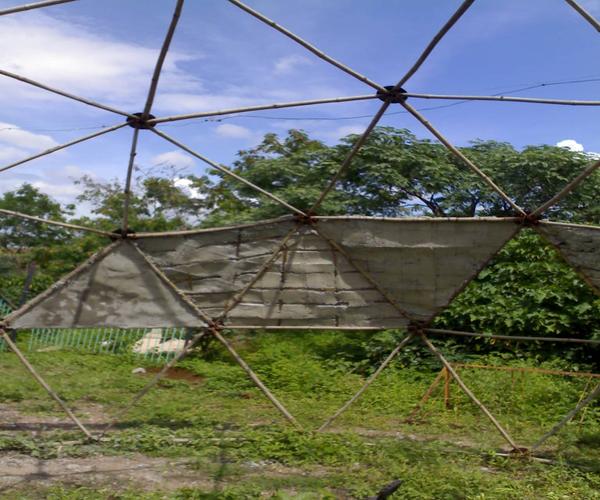 Overview of covered panels
Overview of covered panels
Panels Covered with thin bamboo strips
An experiment was made to cover one triangular panel with thin bamboo strips. Later on the strips were covered with a concrete layer. The concrete did not cover the bamboo strips uniformly and the gaps can be seen in the photograph. The partly exposed bamboo strips are a potential breeding ground for insects. They will decay faster than the covered portions.
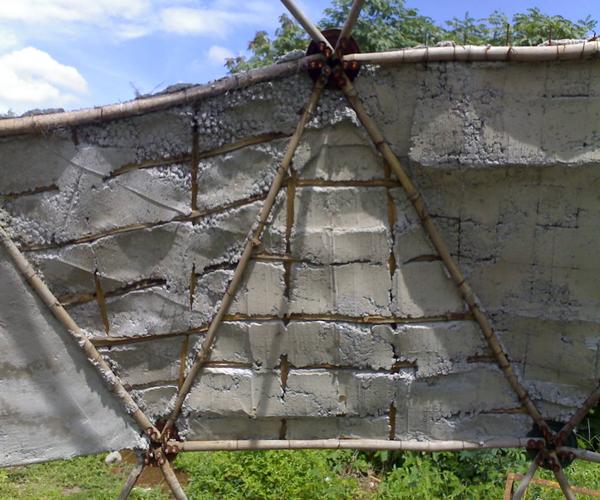 Bamboo-crete
Bamboo-crete
Gaps and Chinks
Other similar covered panels also do not revel a better picture. Gaps and chinks can be seen within right hand side panels that were covered by bamboo strips.
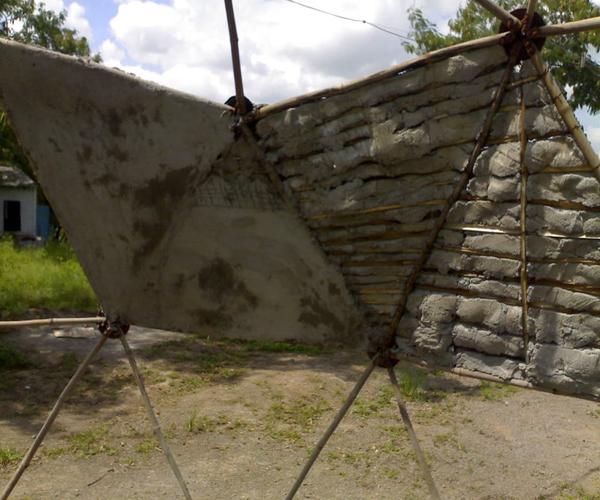 Gaps and chinks
Gaps and chinks
Ferro-crete Panels
Vigyan Ashram has a long history of covering dome shells with ferro-crete. Chicken wire mesh is first spread over the panel. A layer of concrete is spread over the wire to cover the panel. Ferro-crete panels had no defects. Though no formal tests have yet been conducted, the panels sounded good and solid on being hit with a fist.
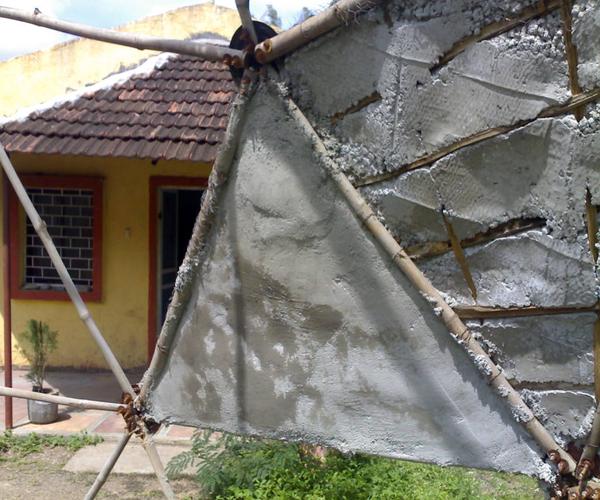 Good Ferro-crete panels
Good Ferro-crete panels
Bill of Materials
The easiest way to generate a Bill of Material for the dome is to use the facilities available at the Desert Dome web site. The home page gives you the option of choosing domes of various frequencies. We want a 3 frequency dome so we choose it to get to the page shown in the picture.
 Reverse Calculator BOM
Reverse Calculator BOM
The beauty of the calculator is that you do not have to choose the units. You enter a pure number and it calculates the results. You can then choose to decide if you want to interpret the results in feet or meters or whatever the unit you feel like. Here we want a dome that is 3 meters in radius (about 10 foot). So we have entered '3' in the cell at the top and it has calculated the lengths of 'a', 'b' and 'c' chords. Note that the 'c' chord is the longest. This is always true. The 'c' chord is 1.237 meters long, which is fairly short by bamboo standards and is about the size show in the pictures. For 3/8 dome, which is what was built at Vigyan Ashram, we need 30 numbers of 'a' chords of 1.045 meters length, 55 numbers of 'b' chords of 1.210 meters length and 80 numbers of 'c' chords of 1.237 meters length. The total length of Bamboo chords actually utilized is 196.86 meters. Add an approximate 20% for cutting length waste which takes the gross length to be purchased to 236 meters or approximately 800 feet of Bamboo. At ₹ 3 per foot the cost of bamboo comes to ₹ 2,400. In US dollars at currency rate of ₹ 46 = 1 US $ the cost is US $ 48. The site gives hubs in 4, 5 or 6 connectors sizes. We have used only 5 and 6 connector hubs forgoing some savings for simpleness of execution. We have used a total of 61 hubs. At ₹ 10 per hub the cost comes to ₹ 610 or US $ 13. The total of Bill of Materials comes to ₹ 3,010 or US $ 61.
Bill of Materials Assembly Diagram
The Desert Dome Calculator also generators an assembly diagram. The diagram is only conceptual and is of little guidance in assembling the dome. But do see the reverse calculator on the site and understand its benefits that are also explained on the next page.
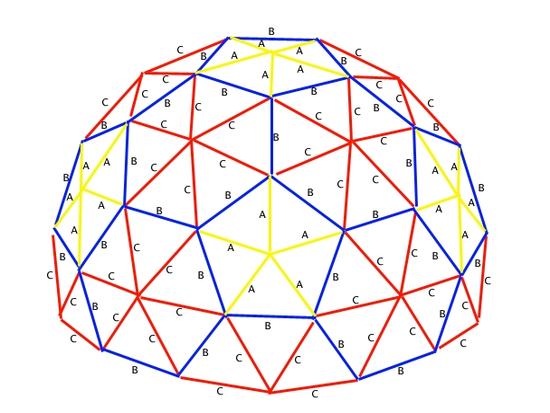 Assembly Diagram
Assembly Diagram
Bill of Materials by Reverse Calculator
In building structures from Bamboo, we may wish to proceed with caution. For instance we may subjectively determine that the longest span of bamboo of a particular diameter that we wish to use is 5 feet long and want to know what is largest dome we can build? From the home page of Desert Domes we choose the Reverse calculator link and reach the page shown. We enter 5 in the cell on the top and it calculates the radius. The cell labeled "Radius" shows that we can build a dome of 12. 123 feet radius. The BOM can easily be calculated from the data shown in the picture as the data is essentially arranged in the same way as before.
 Reverse Calculator BOM
Reverse Calculator BOM
External Links
Desert Domes
Desert Domes is a rich site for all sorts of resources on Geodesic Domes. It hosts instructions for making a Geodesic Bamboo dome that requires no hubs and joins only four bamboos at a time. Only two different lengths are used. The instructions are taken from page 95 of Domebook Two by Lloyd et al. eds. Kahn; Shelter Publications; 1972.
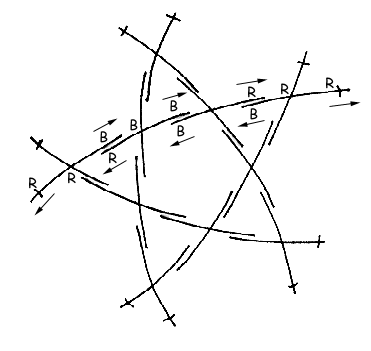 Basic Unit of the Bamboo Dome
Basic Unit of the Bamboo Dome
Conbam Domes
CONBAM Domes are a sophisticated manufacturers of Bamboo domes. They use complex building techniques that work in layers. One layer is based on a Geodesic dome while the other layer is a hex-pent mesh.
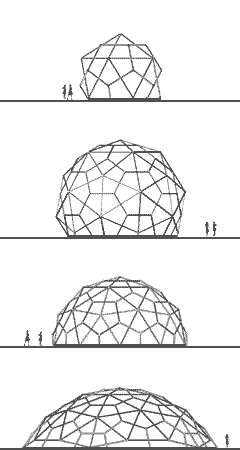 Relative Sizes of Conbam Domes
Relative Sizes of Conbam Domes